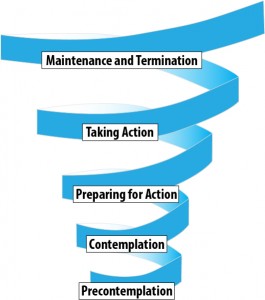At some time in our life, there is a good chance we have tried to change our behavior. It could be to lose some weight, start saving money, trying to quit a bad habit, etc. Sometimes these types of behavior changes occur gradually, sometimes abruptly. Whether quickly, or over time, change usually occurs throughout a series of stages. These stages are outlined in the Prochaska Spiral, more commonly referred to as the “Transtheoretical Model of Behavior Change,” or TTM (for short).
TTM was founded in the early 1980s through the work of psychologist James O. Prochaska, Ph.D. This “readiness to change” model has enthused many to re-evaluate theories about the most useful, apposite means of sustaining one’s self to achieve goals in relation to altering their behavior. The process is captured in the Prochaska Spiral.

The Prochaska Spiral
Initiating one’s self into action is frequently more difficult than “just doing it,” and possibly less productive than anticipated. Without the proper emotional preparedness to tackle a particular goal, a person may actually sabotage their success. Prochaska devised a six-point model to clarify that lasting change seldom takes place due to a single ongoing resolve to act. More often than not, change develops from an understated, multifaceted, and at times, tortuous progression. A process that includes various phases of mental attentiveness such as thinking, pausing, going forward, going backward and sometimes starting all over again!
The Six-Stages of the Transtheoretical Model
Prochaska’s TTM hypothesis recognizes that enduring modification in a person’s behavior generally advances through six crucial stages: Precontemplation to Contemplation, and onto Preparation and Action. However, this is just the beginning, as individuals can indubitably slip back into the Preparation or Contemplation stages if they lose their resolve.
For behavioral changes to be solidified, a person must enter into the Maintenance phase until the changed behavior “sticks,” so to speak. The final stage called Termination means that the transformation is complete and permanently instilled in the person’s lifestyle.
-Precontemplation
Individuals in this phase desire to change; however, actual plans have not been conceived. This is because they may not be wholly cognizant of the potential advantages; they may be discouraged due to the failure of past attempts, or lack energy.
-Contemplation
Those in the Contemplation phase are considering taking action, but are not altogether ready, or, do not understand how to go about getting started. They are open to feedback and information. This is somewhat a “dilly-dallying” stage.
-Preparation
At this stage, people are geared to take action. They are more strong-minded, certain, and dedicated. They are developing their plan of attack and may have already taken action in small steps.
-Action
Apart from just thinking about acting, a person at this stage is actually doing something. This stage is when all the prior small steps, seeming irrelevant choices, and small sacrifices come together to make a significant difference.
-Maintenance
Persons in the Maintenance phase have maintained the “Action” phase for a minimum of six months. This means that they have providentially shunned or conquered the obstructions that could have caused them to lapse into previous behaviors.
-Termination
When individuals in the Maintenance phase prolong their healthier behavior for at least two years, they go into Termination. In the Termination phase, the new behavior is wholly integrated and the temptation to relapse into old behavior has weakened. This constituent of behavior modification is no longer something an individual needs to do. It is part of their standard operating procedure.
Why the Prochaska Spiral is Important
The idea of comprehending the art of behavioral change is for a person to develop the life of their highest choosing. By integrating a particular lifestyle change that benefit’s them, they are reinforcing within themselves that they have the ability to do it. When people explore how they may utilize their vigor, awareness of self, and the acumen they’ve gained to embark on new areas of challenge or learning, growth occurs. This is why the Prochaska Spiral is so important, it acknowledges that change takes time; thereby, setting individuals up to succeed.
